Experience More
Three of the country’s great universities – Meiji, Chuo, and Nihon – started out in this area in the 1870s and 1880s, and soon booksellers sprang up selling both new and used books. At one time as many as 50 percent of Japan’s publishers were based in this district.
Although only Meiji University and Nihon University are still in the area, dozens of bookshops, including several selling ukiyo-e prints, remain, all clustered around the junction of Yasukuni-dori and Hakusan-dori. For English books on Eastern subjects, try Issei-do or Kitazawa Books; for ukiyo-e prints, visit Ohya Shobo – all are on the south side of Yasukuni-dori, walking away from Hakusan-dori.
The change in the economic status (as well as pastimes and priorities) of Tokyo’s university students is evident in Jimbocho Booksellers’ District. Shops selling surf- or snowboards are now everywhere, and music shops full of electric guitars seem as numerous as the bookshops.

t Browsing through stalls selling secondhand books in Jimbocho Booksellers’ District
Did You Know?
The Japanese word tsundoku means “to buy more books than you can ever read.”
Designed by the renowned American-based architect Rafael Viñoly, and completed in 1996, the International Forum is one of downtown Tokyo’s most distinctive buildings. A bustling cultural center, it is made up of two buildings: a curved, glass atrium soaring 200 ft (60 m) into the sky, and a white, cube-like structure housing four halls (with the largest able to seat 5,012). A tree-shaded courtyard separates the two, while glass walkways provide an overhead link. The interior of the huge atrium is filled with natural light and has a ceiling resembling a ship’s hull. There are plenty of shops, cafés, and restaurants, as well as conference rooms, all supported by state-of-the-art facilities. High-speed internet access is available in the entrance lobby.

t The enormous sleek interior of the Tokyo International Forum

Insider Tip
Market Days
The best time to visit the Tokyo International Forum is on the first or third Sunday of the month when the Oedo Antique Market – the largest in Japan – takes over the forecourt with overflowing stalls.

t The entrance to the much-reconstructed Kabuki-za Theater
Tokyo’s principal theater for Kabuki opened in 1889 during the reign of Emperor Meiji as part of Kabuki’s shift from daytime entertainment for the masses in Asakusa to a more high-brow art form.
The theater has seen many incarnations over the years, but still employs traditional Japanese designs. It was almost destroyed by the Allied bombing of 1945, and was rebuilt in 1951, only to be demolished yet again in 2010. The theater reopened in 2013, and enchanting performances, including dance, historical plays and updated Kabuki plays, take place here most evenings.
Experience Central Tokyo
Japanese Traditional Theater

t The hero of a No performance fighting a masked demon
Four major types of traditional theater are still performed regularly in Japan: No, Kyogen, Kabuki, and Bunraku. Originating in Shinto rites, No became more ritualistic and ceremonial, before splintering into different forms designed to entertain the masses.
NO
First performed by Kan’ami Kiyotsugu (1333–84), No is a restrained but powerful theatrical form. One or two masked characters appear on the bare stage at a time, and perform slow, choreographed actions (kata) to music.
KYOGEN
This form evolved from comic interludes devised as relief from the demanding nature of No. A down-to-earth, colloquial form, its characters highlight human foibles. Rather than masks, the actors wear distinctive yellow tabi socks.
KABUKI

t Elaborately dressed Kabuki performers on stage
If No is stark, Kabuki is flamboyant and colorful. Elaborate make-up replaced No masks, and a curtain allowed set changes. Although Kabuki was founded by a woman, all actors are now male, and female roles are played by highly skilled onnagata.
BUNRAKU
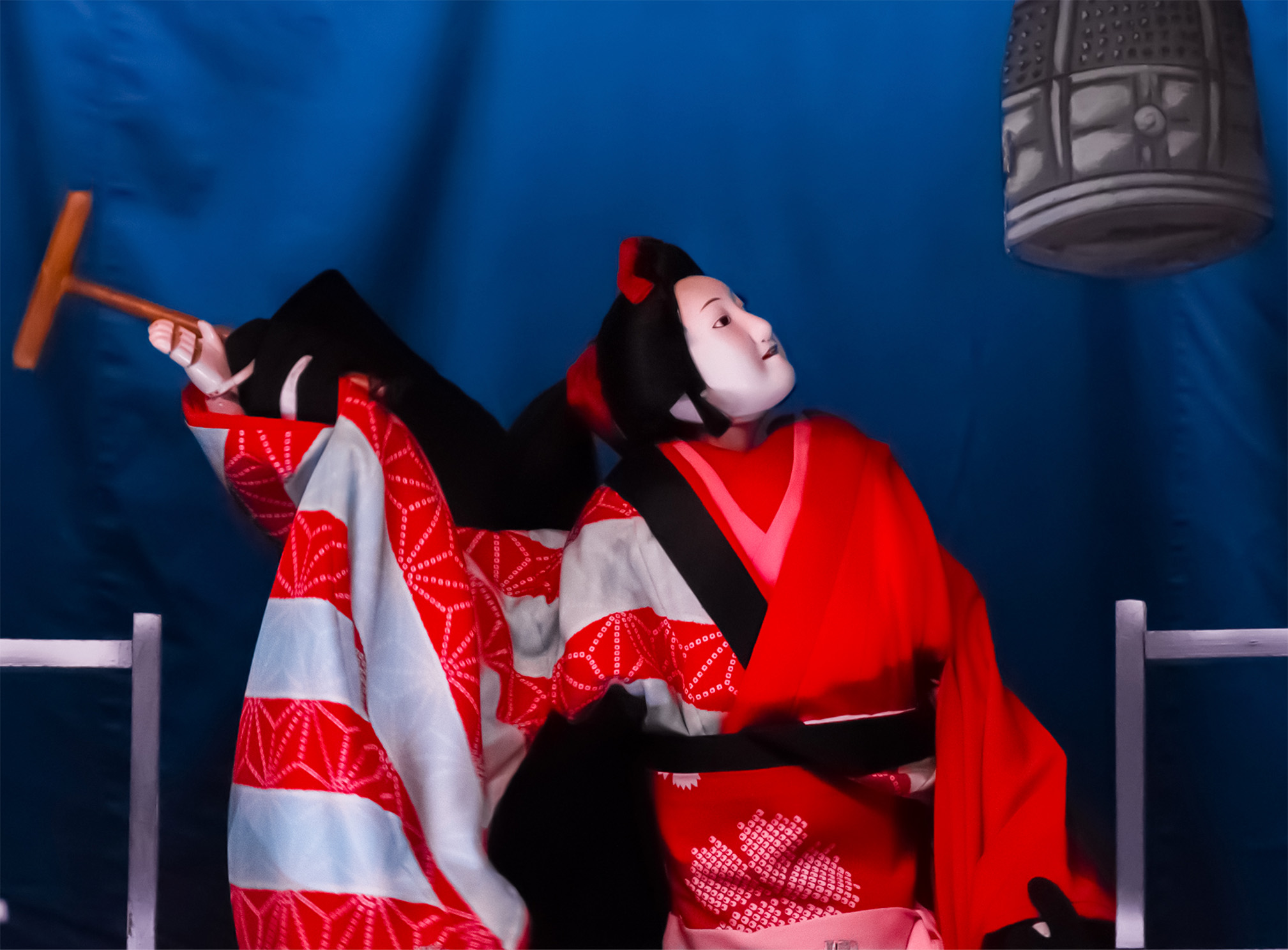
t A Bunraku puppet striking a ceremonial bell
Elaborately dressed 4-ft- (1.2-m-) high puppets are manipulated by a puppeteer and his two assistants. Shamisen music accompanies the action, and a narrator both tells the story and speaks all the parts.

t A stream running through the charming, tree-filled Hama-rikyu Gardens
Experience Central Tokyo

t Nakajima teahouse in the Hama-rikyu Gardens
Situated where the Sumida River empties into Tokyo Bay, this 62-acre (25-hectare) garden dotted with colorful and fragrant plants like camellia and azalea was built in 1654 as a retreat for the shogun’s family, who also hunted duck here. The garden has had an illustrious history. The US president Ulysses S. Grant stayed in a villa in the gardens during his visit in 1879 and sipped green tea in Nakajima teahouse.
The garden grounds surrounding the duck ponds are still a pleasant and uncrowded place to stroll and unwind, although all of the original teahouses and villas, trees, and vegetation burned down after a devastating bombing raid on November 29, 1944. But Nakajima teahouse has been faithfully rebuilt, appearing to float over the large pond. Green matcha tea and delicious, traditional Japanese sweets are available here.

Insider Tip
All Aboard!
A cruise on the Sumida River from Hama-rikyu Gardens to Asakusa in Northern Tokyo offers a little-seen view of the city. In spaceship-like or retro-style boats, you’ll pass under bridges, take in the city’s soaring skyscrapers, and see people relaxing in the parks by the water. Near Asakusa there are long, low boats that take out groups for lantern-lit evening cruises (www.suijobus.co.jp).
Completed in 1936, the Diet Building houses the legislature of the Japanese government, originally established as the Imperial Diet in the Meiji era. Tours (in Japanese only) cover the well-worn inside, including the Diet chamber, where you can see the deliberations of Diet members, and the extravagantly decorated rooms formerly used by the emperor for official functions.
Nearby, you’ll find Central Tokyo’s only Western-style park, Hibiya Park. Its location, close to the political centers of Kasumigaseki and the Diet Building, makes it a favorite place for protests, especially on May Day. The large bandstand is used for concerts.
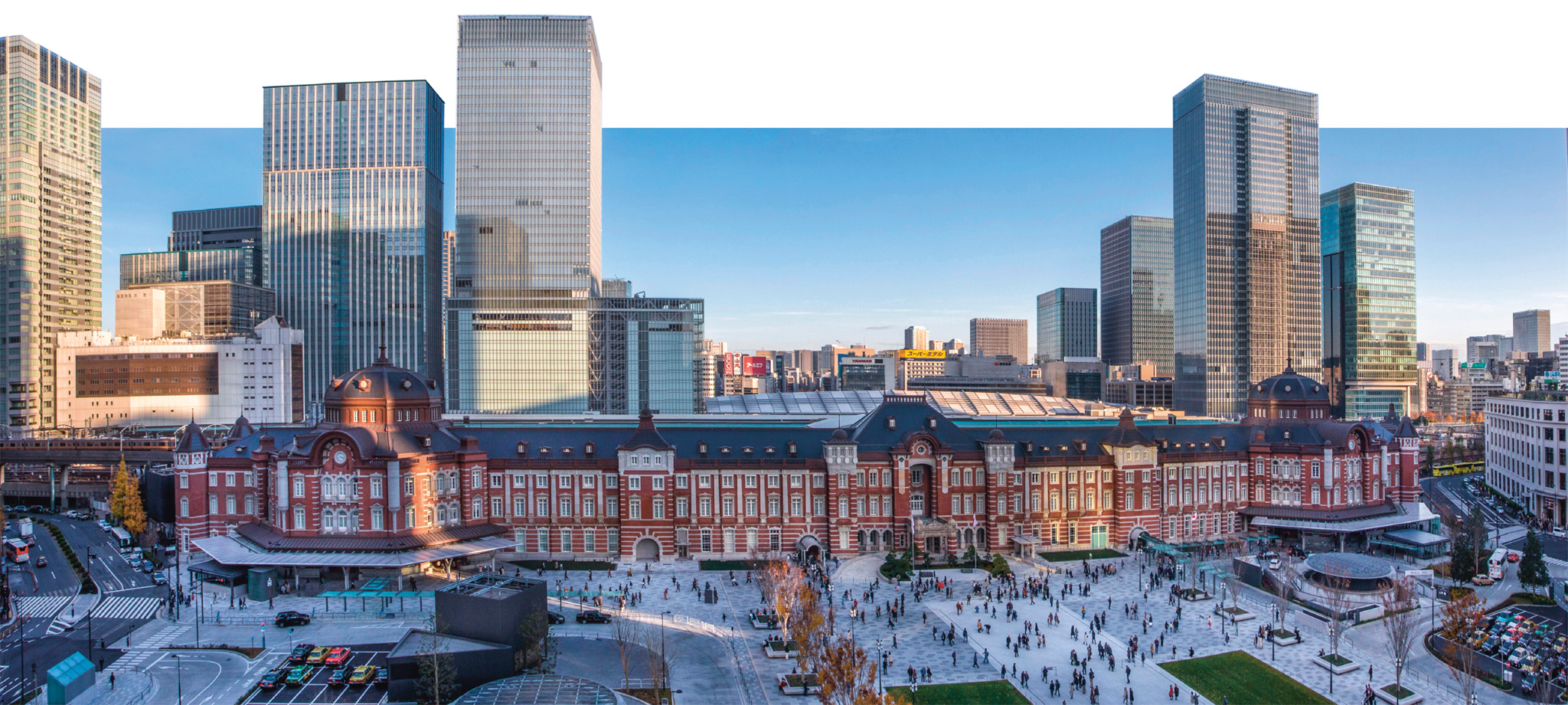
t The grand entrance to Tokyo Station, in the Marunouchi district
During the Edo era, this district earned the name “Gambler’s Meadow” as its isolation made it an ideal place to gamble secretly. The area was used by the army in the Meiji period before selling it to Mitsubishi in 1890. The arrival of the railroad increased the desirability of this barren wasteland as a business site, and after the 1923 earthquake, many other firms moved here.
Tokyo Station, designed by Kingo Tatsuno and completed in 1914, is supposedly based on the design of Amsterdam’s Centraal Station. Its dome was damaged in the 1945 air raids and subsequently replaced by the polyhedron there today. The original reliefs adorning the domes above the North and South exits are worth a look. Opposite the station’s south gate is the shopping mall KITTE, with the Tokyo City-i information center on the first floor. The English-speaking staff here, including Pepper the robot, offer advice and help to visitors.
For those interested in traditional Japanese arts and crafts, the Idemitsu Museum of Arts showcases the vast art collection of Sazo Idemitsu, the founder of one of Japan’s largest oil companies. The regularly changing exhibits display astonishing examples of Japanese calligraphy and paintings, as well as Japanese and Chinese ceramics.
Tokyo City-i
⌂ 2-7-2 Marunouchi, Chiyoda # 8am–8pm daily ∑ en.tokyocity-i.jp
"
Idemitsu Museum of Arts
⌂ Teigeki Building, 3-1-1 Marunouchi # 10am–4pm Tue–Thu, Sat & Sun, 10am–7pm Fri ∑ idemitsu-museum.or.jp
Did You Know?
During the Edo Period, some of Japan’s most powerful feudal lords resided in Marunouchi.
Experience Central Tokyo
|
Stay Aman Tokyo A glamorous high-rise hotel, with a hot tub in each room. K6 ⌂ 1-5-6 Otemachi, Chiyoda ∑ aman.com The Tokyo Station Hotel Next to Tokyo Station, this luxury hotel is an oasis of calm and peace. K7 ⌂ 1-9-1 Marunouchi, Chiyoda ∑ thetokyostationhotel.jp/en Hotel Niwa Kanda This hotel blends the look of a traditional Japanese inn with contemporary touches. J4 ⌂ 1-1-16 Kanda Misakicho, Chiyoda ∑ hotelniwa.jp |
In the late 1980s, waterfront development became Tokyo’s new frontier. The Shiodome City Center complex, which was opened in 2003, is one of the more successful of these waterfront developments. Within this grove of ultra-modern skyscrapers are the impressive, triangular Shiodome Media Tower, headquarters of Kyodo News and home to Park Hotel Tokyo; and Acty Shiodome, one of the tallest residential buildings in Japan. It is made up of 56 stories, and has indoor malls and an outdoor piazza, providing exciting places to dine or shop. Nearby is ADMT, the Advertising Museum of Tokyo, located in the basement of the Caretta Shiodome, which has the offices of the world’s largest advertising agency – Dentsu.
For further exploration of the Tokyo Bay area, take the Yurikamome Line from Shiodome Station toward Rainbow Bridge, and enjoy great views of the Sumida River and the futuristic island of Odaiba.
The striking Tokyo Tower was erected partly as a symbol of Japan’s postwar boom, as well as to act as the sole broadcasting tower for the whole Kanto region. Two observation decks – the Main Deck at 492 ft (150 m) and the Top Deck at 820 ft (250 m) – offer spectacular views of Tokyo Bay, the nearby districts of Shimbashi and Ginza, and Mount Fuji on a clear day.
As a lofty symbol of the city, it may have been usurped by Tokyo SkyTree, but Tokyo Tower is still worth a visit for the views, as well as for the many amusements, cafés, and shops in “Foot Town”, the building at the tower’s base.
To the east of Tokyo Tower extends Shiba Park, at the center of which lies Zojo-ji, the Tokugawa family temple. It was founded in 1393, and Ieyasu moved it here in 1598 to protect his new capital. The present-day temple dates from 1974; nearby are the rebuilt Daimon (big gate) and the Sanmon (great gate), built in 1622, and the oldest wooden structure in Tokyo.
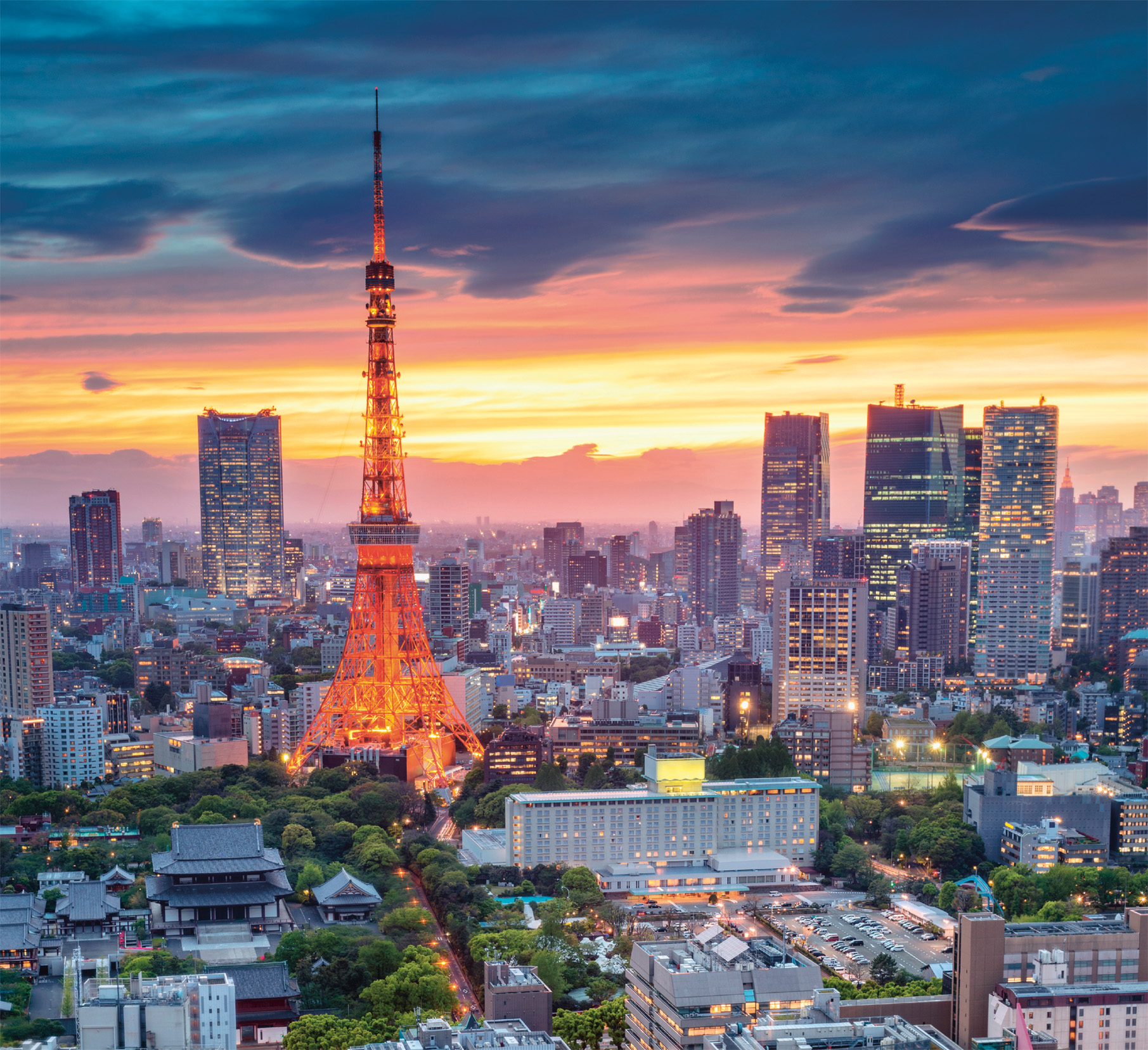
t The soaring Tokyo Tower, inspired by Paris’s Eiffel Tower, seen at sunset
Zojo-ji
Lying to the north of the Imperial Palace, Kitanomaru Park is reached through the massive Tayasumon gate. A former ground for the Imperial Palace Guard, the area became a park in 1969. Before entering, walk past Tayasumon gate on the left to reach Chidorigafuchi (the west moat), one of Tokyo’s most beautiful cherry-blossom viewing spots. Rowboats can be rented here.
Within Kitanomaru’s grounds is the indoor arena, Nippon Budokan. Built for the 1964 Olympics martial arts competition, it is now used mostly for rock concerts. Farther on is the Science and Technology Museum. The fun interactive exhibits include virtual car, truck, and bike rides and electricity demonstrations (explanations are in Japanese).
Five minutes’ walk beyond is the National Museum of Modern Art. The permanent collection comprises Japanese works from the 1868 Meiji Restoration to the present day; visiting exhibits are often excellent. Nearby is the National Museum of Modern Art’s Crafts Gallery. Inside this 1910 Neo-Gothic brick building is an exquisite collection of modern workings of traditional Japanese crafts – pottery, lacquerware, and damascene (inlaid etched metal artifacts). Some pieces are also for sale.
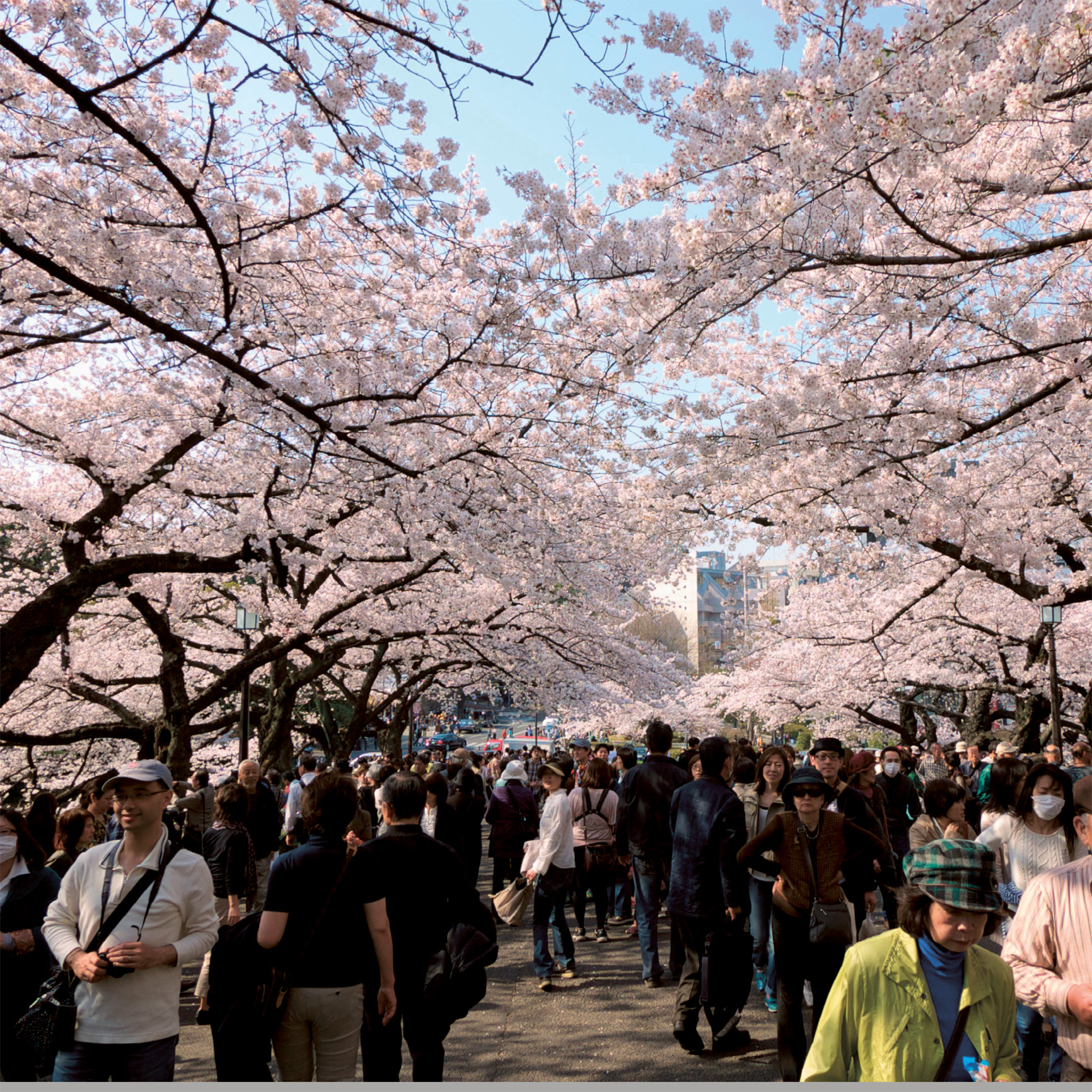
t Strolling in Kitanomaru Park during cherry-blossom season
"
Science and Technology Museum
⌂ 2-1 Kitanomaru Koen, Chiyoda # 9:30am–4:50pm Thu–Tue ∑ jsf.or.jp
"
National Museum of Modern Art
⌂ 3-1 Kitanomaru Koen, Chiyoda # 10am–5pm Tue–Sun (to 8pm Fri & Sat) ∑ momat.go.jp/english/am
"
Crafts Gallery
⌂ 1-1 Kitanomaru Koen, Chiyoda # 10am–5pm Tue–Sun ∑ momat.go.jp/english/am
This is one of Tokyo’s most delightful traditional stroll gardens. Construction started in 1629 and finished 30 years later. Exiled Chinese scholar Zhu Shunsui helped design the garden, including the Engetsukyo (full-moon) bridge, a stone arch with a reflection resembling a full moon. Tsutenkyo bridge is striking for the contrast between its vermilion color and the surrounding deep-green forest. The garden represents larger landscapes in miniature, including Rozan, a famous Chinese mountain, and Kyoto’s Oikawa River. In the middle of the large pond is Horai Island, a beautiful composition of stone and pine trees.
Did You Know?
Zojo-ji temple in Shiba Park is home to a fifth-century grave mound, untouched by time.
Experience Central Tokyo
|
EAT Rokurinsha You may have to wait in line to get into this popular ramen spot. Try the tsuke-men, where noodles are served separately and dunked into a thickened broth. K7 ⌂ 1 Chome-9-1, Marunouchi, Chiyoda § (03) 3286-0166 Sushi Shin Located in the Mandarin Oriental, this Michelin-starred sushi restaurant offers a stunning view of the Tokyo skyline. L6 ⌂ -1-1 Nihonbashi Muromachi, Chuo § (03) 3270-8634 |
The 2.5 million Japanese soldiers and civilians who have died in war since the Meiji Restoration in 1868 are enshrined at Yasukuni Jinja (Shrine of Peace for the Nation). It is a sobering place to visit.
Until the end of World War II, Shinto was the official state religion, and the ashes of all who died in war were brought here regardless of the families’ wishes. Controversially, the planners and leaders of Japan during World War II and the colonization of China and Korea are also enshrined here, including wartime prime minister Hideki Tojo.
Beside the shrine is the Yushukan, a museum dedicated to the war dead. Many exhibits put a human face to Japan at war; under a photo of a smiling young officer is a copy of his last letter home, and there are mementos of a nurse who died from overwork. Still, romanticized paintings of Japanese soldiers in Manchuria and displays of guns, planes, and even a locomotive from the Thai–Burma Railway may be disturbing to some.
"
Yushukan
# 9am–4:30pm daily
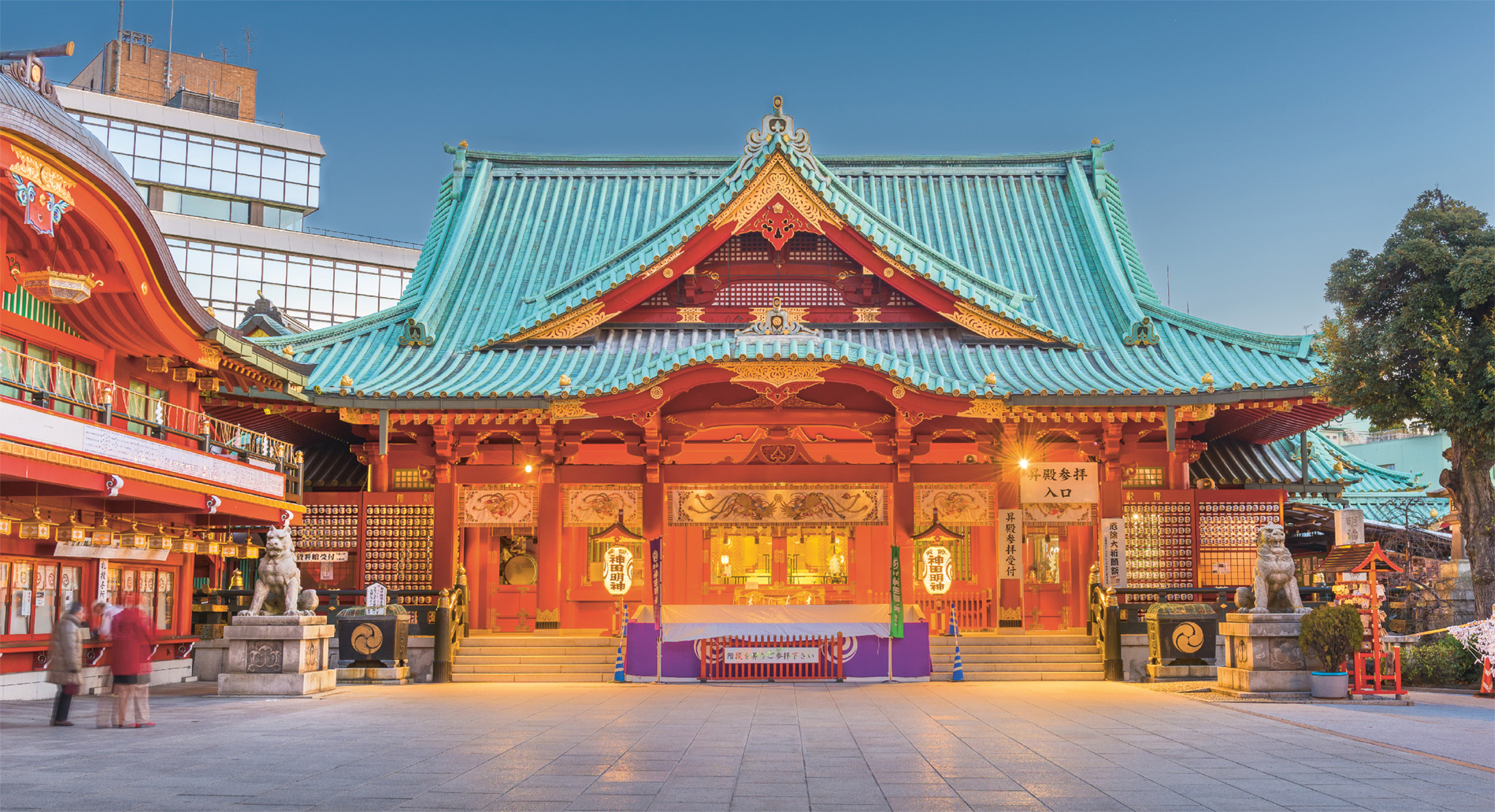
t The distinctive vermilion exterior of Kanda Myojin Shrine
Myojin is over 1,200 years old, although the present structure is a reproduction built after the 1923 earthquake. The gate’s guardian figures are two archers: Udaijin on the right and Sadaijin on the left. Just inside the compound on the left is a big stone statue of Daikoku, one of the shichi-fuku-jin (seven lucky gods). Here, as always, he is sitting on top of two huge rice bales.
The vermilion shrine itself and its beautiful interior, all lacquer and gold and ornate Chinese-style decoration, are very impressive. Early morning is the best time to glimpse the Shinto priests performing rituals. The Kanda Matsuri, celebrated in May, is one of the greatest and grandest of Tokyo’s festivals – come early and be prepared for crowds.
Behind the main shrine is a museum containing relics from the long history of Myojin.
"
Museum
# 9am–4pm daily
The Yasukuni controversy
Since 1869, Yasukuni has honored the souls of those who have died in the service of Japan. The shrine is a place of remembrance for millions of Japanese who lost relatives fighting for their country. Among these, however, are about 1,000 war criminals from World War II. The perception that these souls are being honored has made Yasukuni a site of enormous controversy among Japan’s neighbors who suffered greatly during the war as a result of their actions.
Experience Central Tokyo
Shinto
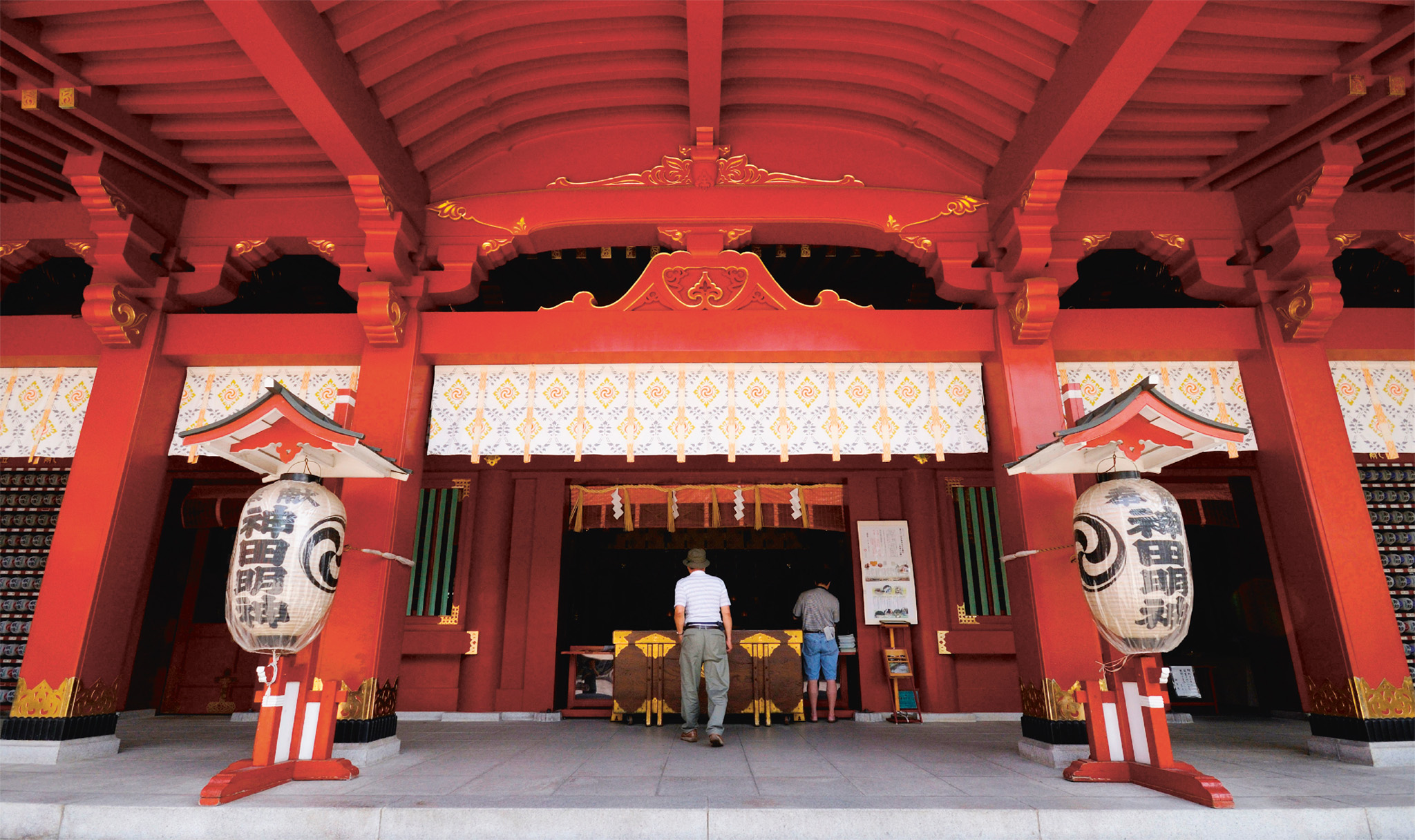
t The brightly colored main hall of Kanda Myojin, a shrine in Tokyo’s Chiyoda district
Japan’s oldest religion, Shinto’s core concept is that deities, kami, preside over all things in nature, be they living, dead, or inanimate. Today, there are few pure Shintoists, but jinja (shrines) still line waysides and Shinto rituals are observed alongside Buddhist practices.
SACRED GATES
The approach to the jinja transports worshippers from the secular to the sacred world. Vermilion torii often line the path, symbolizing gateways, and red-bibbed stone foxes stand guard at Inari Shrines. Inside the shrine’s main complex, shimenawa, a rope made of twisted rice straw, hangs over entrances to ward off evil and sickness.
HAIDEN AND HONDEN
At the haiden, or hall of worship, devotees pull on a bell rope, toss money into a box, clap three times to summon the resident kami, then stand in silent prayer for a few moments. The kami is believed to live in the shrine’s honden (main sanctuary), but usually only the head priests are permitted to enter this hallowed space.
KANNUSHI
The Shinto priesthood (kannushi) tended to be passed down through families, and some of these dynasties (shake) are still connected with certain shrines. Usually dressed in white and orange robes, the kannushi perform purification ceremonies and other rituals.
Experience Central Tokyo
Charms and Votive Tablets
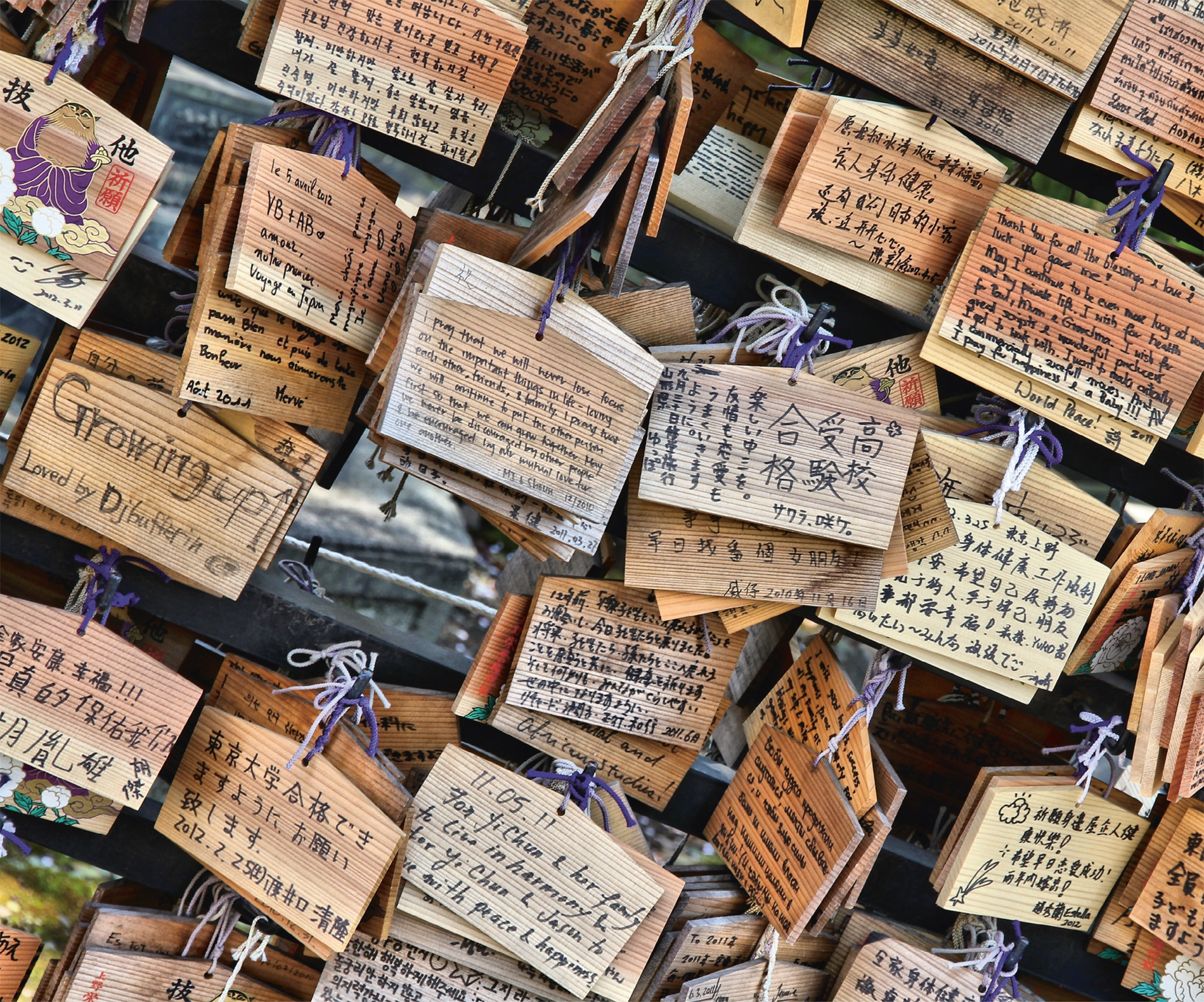

t A cloth bag containing a paper omamori
Good-luck charms, called omamori, are sold at shrines across Japan. Common themes relate to fertility, luck in examinations, general health, or safety while driving. The charm itself might be written on a piece of paper or thin wooden board and tucked into a cloth bag, which can be worn next to the body or placed somewhere relevant. Do not open the bag to read the charm or it will not work! Prayers or wishes can also be written on ema boards (above) and hung at the shrine.

